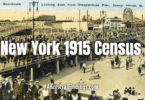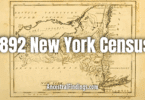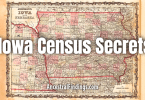We’ve now arrived at the 1920 U.S. Census—the first one taken after the end of World War I. This moment in history holds a lot beneath the surface. If your ancestors were alive during this time, they had just come through a pandemic (the 1918 flu), experienced wartime hardship, and were witnessing a country beginning to shift from rural traditions into a modern age. The census taken in January 1920 captures Americans right as the Roaring Twenties were warming up.
I always find this census one of the more reflective ones. It’s not just data—people pick up the pieces, build again, sometimes move to new places, and sometimes adjust to deep losses. And that comes through in the questions that were asked and the answers your ancestors gave. Whether you’re tracing great-grandparents, immigrants, or just curious about the records, the 1920 census is rich with clues.
What Makes the 1920 Census Unique?
This was the 14th decennial census, and the first was conducted in January (previous censuses were taken in spring or summer). Why January? Officials thought catching people at home during the winter would be easier. That means birth dates and ages should be calculated using January 1, 1920, not April or June like in previous years.
It’s also the first census after World War I, which means many young men you saw in the 1910 census may not appear here. For those who survived and returned, the census gives a first look at their post-war lives—new families, jobs, or even new hometowns.
The 1920 census didn’t include a few things people liked from 1900 and 1910, such as questions about how many children a woman had or whether someone was a Civil War veteran. Those were dropped. But in their place, the census doubled down on immigration, citizenship, and language questions—all crucial for anyone researching immigrant ancestors.
What Was Asked in the 1920 Census?
Here’s a breakdown of the key questions and why they matter:
- Name, relationship to head of household, sex, race, age, marital status. These are fairly standard, but always helpful when verifying families, spotting nicknames, or confirming birth year estimates.
- Year of immigration to the U.S. This is one of the most valuable parts for immigrant research. It helps narrow down naturalization records, passenger lists, and more.
- Naturalization status. Listed as AL (alien), PA (first papers), or NA (naturalized). This shows where an ancestor was in the citizenship process. Combine this with court records and naturalization petitions.
- Language spoken. Especially noted for foreign-born individuals. If your ancestor was still listed as speaking German, Polish, or Italian, that hints at how rooted they still were in their homeland culture.
- Occupation and industry. Like in 1910, this two-part question lets you see what kind of work someone did and in what setting. You might see farmer/general farm, clerk/retail store, or laborer/railroad. It also asked if they were employer, employee, or self-employed.
- Homeownership. Whether the home was owned or rented—and if owned, whether it was mortgaged.
What’s not here? Unlike the 1900 and 1910 censuses, the 1920 census does not include month and year of birth, mother tongue, veteran status, or number of children born/living. So those earlier censuses are still important when reconstructing deeper family stories.
Research Tips for Using the 1920 Census
Search broadly, then narrow down. Name spellings get tricky in this census, especially with immigrant families. Use wildcards when searching. Try alternate spellings and be flexible with ages. A person born in 1885 might be listed as 34, 35, or 36.
Look for nearby relatives. This is a time when families often lived in clusters. If your great-grandfather is on a street in Chicago, look up and down the page—you might find cousins or in-laws just a few doors away.
Pay attention to neighbors with the same place of birth or language. If your ancestor was listed as speaking Slovak and living next to three other Slovak-speaking households, you may be looking at a neighborhood of recent immigrants from the same village.
Watch for transitions. This census captures a lot of movement. Families uprooted by war or economics may have moved from rural areas to cities. Tracking the shift from farm laborer in 1910 to factory worker in 1920 gives insight into broader patterns and personal choices.
Check naturalization clues. If your ancestor was naturalized between 1910 and 1920, this census can help pinpoint when and where. Combine it with WWI draft registrations (1917–1918) to fill in missing details.
Historical Context That Brings It to Life
The U.S. population in 1920 was just over 106 million—and for the first time in history, more people lived in urban areas than rural ones. That’s a huge turning point in American history.
Women were still fighting for the right to vote—ratification of the 19th Amendment wouldn’t happen until August of 1920. So you’ll see women listed as homemakers but not as voters or heads of household unless they were widowed or unmarried. This is one of the last censuses where women are largely represented in the background of legal and public life.
Prohibition had just begun on January 17, 1920. That won’t show up in the census, but it shaped society in ways you might see later—like shifts in jobs, household sizes, or movement to new towns.
Also, the aftermath of the Spanish flu pandemic still lingered. The flu could be a silent reason if a family member disappeared between 1910 and 1920 with no known cause.
Why It Matters for Family History
The 1920 census is one of the most widely used tools for genealogy because it marks a point of stability before the chaos of the Great Depression and World War II. It’s often the last census in which older generations are still alive and the first in which younger ones start to appear with their own families.
It also serves as a bridge between the immigrant story and the whole American identity. If your ancestors came over in the 1880s or 1890s, this is where you see the outcome of that journey—were they homeowners now? Are they still speaking the old language? Did the children list different jobs or birthplaces?
Each column tells part of the story, and it’s your job to read it with curiosity.






